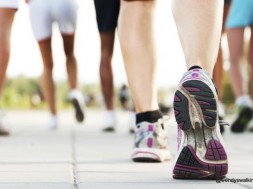How far to walk for minimum fitness – Just Walk!
There are really no hard and fast rules in walking. You can walk fast or slow. You can walk for 30 minutes or 30 hours a week. It really does not matter as long as you are walking regularly and are not leading a sedentary life. Fitness is after all about a moderate level of physical activity at regular intervals.
Waking in order to attain a minimum level of fitness however requires following a target. The rule of thumb is to devote at least 30 minutes a day to walking or around two miles a day. Walking at least two miles a day at 40 percent to 55 percent maximum heart rate can result to a one-percent loss of body weight, 1.6 percent off your waistline, two percent loss of body fat and 0.7 percent more muscle.
The daily minimum requirement of two miles a day also offers optimum health benefits such as lowering the risks of heart-related diseases such as hypertension, stroke etc., diabetic conditions, bone fractures, muscle disorders among other medical ailments. It also promotes good sleep and reduces stress and anxiety.
The pace of your walking regimen largely depends on your physical well-being. Thus if you are walking to lose weigh, it is best to consult your doctor, who can best advice you what your body can or cannot do. In the same way that a certain diet is not recommended to just about anyone. Walking for fitness has some limitations for some people such as the elderly or those with medical conditions and physical disabilities.
To achieve a minimum level of fitness from walking, you can also design your own walking program or sign up and join a walking club, which is becoming increasingly popular in communities or you can download a walking program from fitness websites. This usually includes a walking task or assignment, tips, inspirational guides and, nutrition or diet recommendations. The program is also customized for beginners and experienced walkers. Thus, you can walk at your desired pace, there is no risk of overexerting yourself.
To avoid overexerting yourself and walking-related injuries, you should know your limitation and seek your doctor’s advice. Oftentimes, it’s a matter of listening to what your body is telling you. Slow down if you have to. Walking for fitness is not a race. It is also wise to cool down or relax after every walking session.
It is also good to assess you fitness performance by keeping track of your walking progress. This is done through an inexpensive device such as a pedometer, which can measure the number of footsteps as well as the distance walked and even calories burned. There is also a more high-tech device that uses global position system (GPS) satellite technology to monitor and tally the distance you walk and calculate your speed. These devices can be attached on your wrist, arm, shoe or clothing. You can also maintain a walking journal where you can record the distance you cover each time you walk.





